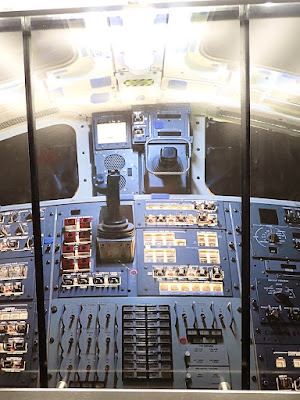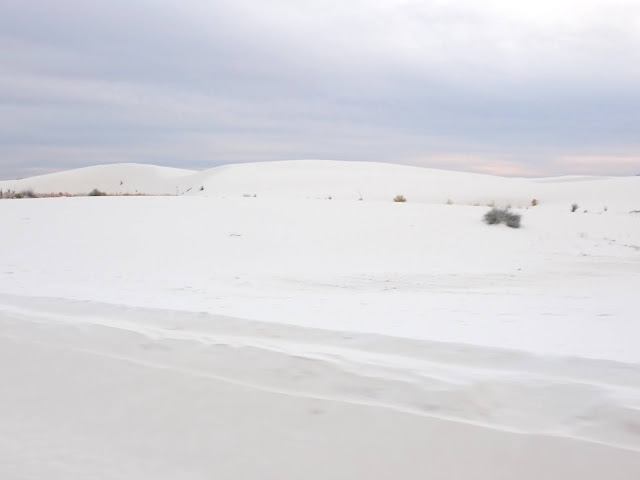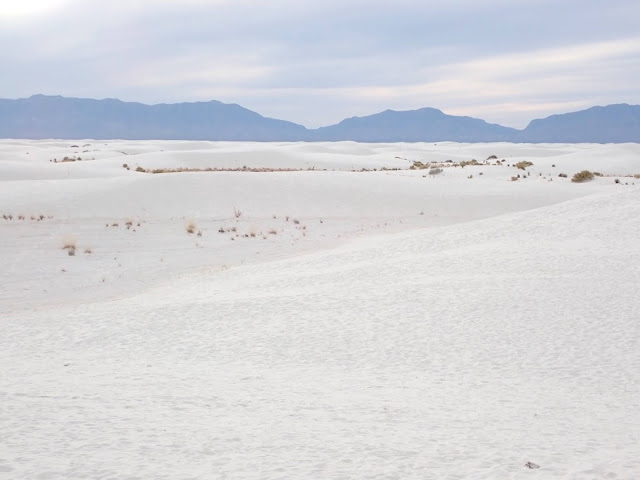16 December 2021

The eldest of my three brothers lives in Las Cruces, and Richard's old college buddy (F) and his wife (J) are wintering in Santa Fe, NM. Turns out Las Cruces is just about halfway between Tucson and Santa Fe, so it seemed like a good place 
We found a nice hotel near the oldest part of the city, and met up with my brother for our first night. We knew the next few days would be busy exploring the region with our friends. Turns out they came to the same restaurant we picked for dinner!!! It was funny and unexpected, but we made plans to meet up the next day.
It isn't always easy coordinating four adults, but we agreed a drive vaguely north to Alamogordo and the White 
Turns out that Alamogordo is home to the New Mexico Museum of Space History, which not only explains how this area became vital to the US space program, but also houses the International 
This museum ended up being much more fun that I had imagined. There were many interactive exhibits, and while there were detailed explanations, many things were geared to involve children in learning about space exploration.
Just for starters, the two elevators looked like the entrance to some of the space ships. And inside each elevator were images of the control panels for, well, whichever space ship. So of course J and I started pretending we were flying the space ship as we rode to the top floor, pushing buttons and the 
There were various capsules and space suits, all kinds of technical information about the race to space, the propulsion of space ships, and one thing that confused me, using gyroscopes to navigate. (Because once in space, a 
The most fun things were flight simulators! J and I had a great time - we both crashed the space shuttle on our first try as it was returning to Earth, though my second attempt was more successful. Then there was the simulator to land a probe on Mars (I 
Anyway, if you're 
A quick lunch, then we headed back toward Las Cruces so we could go to White Sands National Park. This was fascinating, even though the temperatures had dropped a bit and the sky clouded over.
White Sands is one of 
So, White Sands is a 275 square mile (or 712 square kilometers) field of white gypsum sand crystals. This isn't regular sand, like on beaches - this is soft and powdery, and white like snow sand. During rainy season, 

There are various animals living on and in the dunes, and these animals have adapted to this very unusual environment. Some animals have 
All that information, and more, came from the visitor's center, so definitely stop there. They have a film that explains everything, as well as a nice gift shop.
Interesting, and pretty much the only place like this on earth! For more info, here's the park's website: https://www.nps.gov/whsa/index.htm
The outer edges of the huge dune field had various grasses and desert plants like yucca and agave. The plants help to stabilize the dunes, although the shapes and sizes of the dunes constantly change due to wind, rain, and people running or sliding down the dunes.
We drove around, first on tarmac roads, and and then on roads that were packed gypsum sand. It really was like driving around on snow, without the sliding on ice effect. We parked at a couple of places so we could walk on the boardwalks over the dunes, and look at all the plants. Didn't see many animals except some birds, and one large dead beetle.
We did climb up a few dunes, and from the top it's like looking across rolling hills of snow. Really, it's that white. Totally other worldly. Quite a few movies have used White Sands as alien or outer space locations, and this national park really does have that feel. It really is a strange, almost eerie place, especially as the day became more and more grey.
The most disorienting part was that yes, initially the dunes look like regular beach dunes. But then, there are blue-purple mountains in the distance. And somehow, craggy mountains and sandy dunes don't quite go together in our human experience. In some of the photos, the bluish mountains actually look like the ocean in the distance! I know it really isn't the ocean, but I think our brains are so used to sand and ocean going together, we unconsciously pair them and so we see what we THINK we should see, not what we actually are viewing! Totally disorienting!
Of course, the other part of my brain kept whispering "snow! It looks like snow!" This while I was climbing hills and dunes of "snow" in my bare feet. Another moment of confusion because somehow, this just didn't quite compute!
If you ever get a chance, go here. Seriously, it was fun and confusing and weird and absolutely worth it! (Lots of photos, but more narrative after them.)


Mesilla was the capital of the Confederate Arizona Territory, which encompassed modern-day 
Billy the Kid is probably the most famous (and notorious) citizen - he was sentenced to death at the county courthouse, and the building 
A bit gruesome, I know, but such was life in the Old West. One building had a sign telling story about the man who ran erected that building which housed his business. He was murdered, and a relative took over the business. He was murdered, and another relative took over. Several relatives were killed in similar ways, then some business partners. I lost track of how many unlucky businessmen died in that one location.
But there was a pretty church that dated back to 1851, although the present building was put up about 50 years later. There's a lovely park with pecan and pistachio trees, both nuts grown in orchards throughout the region. The buildings are 100 to 150 years old and are colorful, and there are interesting shops to browse as well as tasty treats to eat.
We moseyed in and out of shops, sat in the park enjoying the sunshine, and nibbled on some of those treats. It was a nice way to spend our morning.

Unfortunately, the interactive part didn't quite include a petting zoo sort of experience, but we did learn all about milk cows. Turns out New Mexico is the #6 state in milk production in the US! Who knew? I always think of New Mexico as being desert, but much of the state is dedicated to milk farms! We talked to several cows, and the calves were very interested. Well, there was someone going around feeding the animals, and it was more likely the cows and calves were hoping we were the next feeding crew. But they were quite cute, as were the sheep. The big longhorn steer were rather intimidating, though they didn't make any threatening moves. I kept my distance, and was glad they were fenced in.
It was an interesting museum, especially having so much outdoor space in the working farm area. Another place worth visiting!

But it's one of those oddities that is remarkable, especially since there really wasn't any information available at the rest area.
The geology in this part of the state changes from deserts ringed by hills and mountains, to giant rocks piled in odd formations. We have no idea how they came to be here, how they were formed, anything. Just huge giant boulders, bigger than cars, bigger than semis and trailers. And signs all over saying don't climb on the rocks!
So, since there wasn't any information, we've named a few of the rock formations.
There's the Breaching Whale:
And the Sleeping Elephant:

I'll close with a map showing our route around New Mexico. I-10 goes straight from Tucson to Las Cruces, so I didn't bother to include the map of Arizona. Our drive into NM is red, and the drive to Alamogordo and White Sands is in magenta.






























Wonderful travelogue, as always. Interesting area.
ReplyDeletebarb
1crazydog
Enjoyed my virtual trip. It's been about 40 years wince I visited White Sands and I don't recall seeing any plants in the areas we trekked. Thank you for sharing.
ReplyDeleteWow, I have never heard of White Sands! It looks so unique and beautiful. I've never been to NM but I would like to go there. I also didn't know about dairy production there - I too think of it as being desert - in my mind I think of the mid-west when I think of dairy production
ReplyDeleteWhite Sands almost as if you'd successfully landed one of your space ships on a new planet!! Eerie!! And packed as usual with glorious photos plus entertaining info!! You have a huge talent for sharing your travels, having fun all the way with your jet sounds and boulder-naming!!
ReplyDeleteI've been all the places you mention here except the farm and ranch museum. My husband flew the Stealth at Holloman. Went there several times to get kids for visitation, reunions, and such. It's a super interesting area and you blogged about it well. GREAT pictures!
ReplyDeleteHmm, seems you have sparked a few memories, holiday travel with the family, all that "stop,stop" I want to see; and oh yes, " now! I need to "?", "pull over!!" Safe travels!
ReplyDeleteLoved the pictures and your trip. What a great place to visit!
ReplyDelete